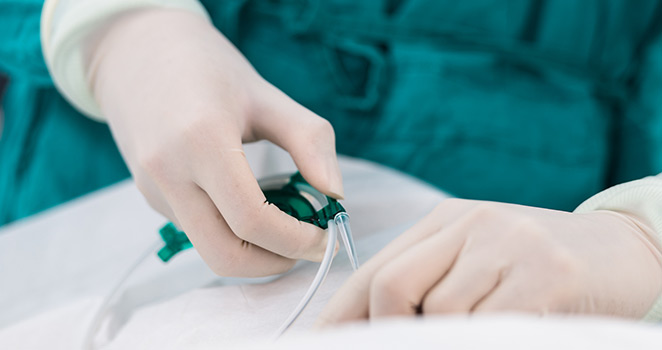Atrium Health Navicent Heart & Vascular Care
Minimally Invasive Endovascular Surgery

What Is Endovascular Surgery?
Endovascular surgery arose from the field of interventional radiology and refers to an alternative to vascular surgery that targets the inside of the blood vessels. Minimally invasive endovascular surgery can be used to treat a variety of vein disorders and diseases and offers patient's shorter recovery times and smaller scars than with traditionally invasive surgery.
Performed primarily by interventional radiologists, minimally invasive endovascular surgery is employed throughout the country and enjoys a relatively short recovery time, little trauma to the patient, and much fewer of the risks associated with vascular surgery.
What Venous Diseases are Treated by Endovascular Surgery?
The primary disease treated by endovascular surgery is Deep Vein Thrombosis (DVT). A thrombosis is a blood clot within a deep vein, usually in the legs. This blood clot can cause swelling, pain, redness, warmth, and engorgement of superficial veins. Deep vein thrombosis itself is not life threatening, but can cause severe chronic pain.
Deep vein thrombosis often results in pulmonary embolism, however, and this can be life threatening. A pulmonary embolism occurs when the blood clot in a deep vein travels to the lungs and blocks the arteries supply the lungs with blood. This can cause shallowness of breath, heart palpitations, and fainting.
Another common disease treated by endovascular surgery is varicose veins, which results from weak valves, which causes pooling of the blood at the veins, leading to swelling, pain, discomfort, and cosmetic complaints from patients.
Other diseases treated by endovascular surgery include peripheral artery disease (PAD) and aneurysms.
What Is a Minimally Invasive Endovascular Surgery Like?
Minimally invasive endovascular surgery relies on state-of-the-art imaging to diagnose venous diseases. Because these diseases occur deep within the body, modern technology is necessary for doctors to diagnose and intervene. Doctors, particularly radiologists, employ ultrasounds, CT scans, magnetic resonance imaging (MRI), specialized blood tests, and venograms to diagnose venous diseases.
Once a venous disease has been diagnosed, a number of minimally invasive endovascular procedures are available for the doctor and patient to discuss.
Almost all minimally invasive endovascular surgery involves a small incision for access into a primary blood vessel, like the femoral artery, and a catheter is introduced subcutaneously (under the skin).
For Deep Vein Thrombosis, Doctors Employ Four Primary Procedures:
Mechanical Thrombectomy:
The blood clot is removed or dissolved with a specialized catheter mechanically.
Thrombolysis:
Specific medications that dissolve clots are administered through a catheter directly into the clot. Some hospitals are experimenting with using thrombectomy devices in conjunction with thrombolytic medications for optimal results.
Anticoagulant Medications:
Patients are administered medications like heparin and warfarin to prevent clots from expanding. This delicate process requires the cooperation of patients and medical professionals to adjust dosages as appropriate.
Inferior Vena Cava Filters:
Certain patients, due to health, age, or lifestyle, may be unsuitable for anticoagulant medications. For these patients, doctors place special filters in their veins to catch blood clots if they break free, preventing them from reaching the lungs and causing a potentially lethal pulmonary embolism.
For varicose veins, doctors employ a different set of techniques that are equally minimally invasive:
Sclerotherapy:
Using a catheter, a chemical is injected into the veins, stiffening them. This slows the flow of blood prevents them from overfilling and swelling with blood.
Radiofrequency Ablation (RFA):
Heat is delivered into the veins with a catheter to treat varicose veins.
Endovenous Laser Therapy (EVLT):
Lasers are used to treat varicose veins.
How Do I Prepare for Minimally Invasive Endovascular Surgery?
Your doctor will inform you of everything you need to do in order to prepare for surgery. Most commonly, doctors will ask at least some of the following:
Patients should abstain from eating and drinking for a period of time before the surgery.
Patients who smoke should abstain from smoking for at least two weeks prior to the surgery.
A physician will conduct a thorough physical examination to check to see if you are healthy enough to undergo surgery.
Tests may be performed to determine the health of your heart. Common methods include a stress test and an electrocardiogram (ECG).
What Are the Risks of Minimally Invasive Endovascular Surgery?
Like all surgeries, endovascular surgery is subject to a number of risks, including infection, leaking of blood, and blockage of blood flow, fever, burst artery, or kidney injury.
However, complications are very rare in minimally invasive endovascular surgery, and the techniques employed are highly sophisticated, designed for the shortest amount of trauma for its patients. Recovery times are also much shorter than with most traditional surgeries.
How Long Is the Recovery Period After Minimally Invasive Endovascular Surgery?
The recovery time after endovascular surgery is usually about two weeks in total. Patients may feel weak or experience reduced energy and appetite during this period, though they will usually be allowed to walk the day of the surgery.
Most patients end up spending two or three days in the hospital for monitoring and extra support if necessary. After returning home, it is recommended that patients take sponge baths rather than a shower, or bathe normally to keep the open wounds dry.
Patients will have to follow up with their doctors after two weeks for a general function. Imaging scans are performed one and six months after the procedure to once again check that, everything is normal.
How Can I Prevent Deep Vein Thrombosis?
In order to avoid deep vein thrombosis and endovascular surgery altogether, it is important to exercise regularly, maintain a healthy weight, and to eat a balanced diet. Most blood clots can be prevented by lifestyle decisions and are much more manageable when the patient is physically healthy.